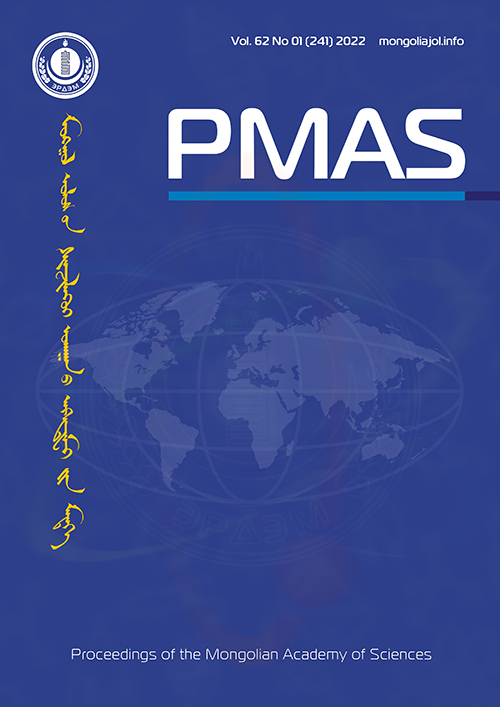Lithology and the content of some major elements in the sediments of Buir Lake, East Mongolia
DOI:
https://doi.org/10.5564/pmas.v62i01.2084Keywords:
Buir Lake, major elements, Chemical Index of Alteration (CIA), climatic changeAbstract
The freshwater Buir Lake in Khalkh Gol soum, Dornod aimag, is located (47° 51′ 47″ N, 117° 51′ 29″ E) on the border of Mongolia and Inner Mongolia, China. The northwest and northeast part of the lake is swampy, and is flat in the rest part. This research paper reveals the lithology and some major elements content (SiO2, Al2O3, TiO2, Fe2O3, MgO, K2O, Na2O, MnO and P2O5) of the core sediments and their distribution along the depth and the Chemical Index of Alteration (CIA), which will be a significant factor in restoring environmental change. According to the data of analysis of major elements of Buir Lake sediments, the concentration of SiO2 ranges from 42.92 to 58.29%; Al2O3 = 9.25-12.83%; Fe2O3 = 3.66-4.79%; TiO2 = 0.46-0.62%; MnO = 0.08-0.13%; CaO = 5.73-11.56%; MgO = 1.34-1.81%; Na2O = 0.72-1.50%; K2O = 1.58-2.31%; and P2O5 = 0.14-0.26% respectively. The chemical index of alteration is basically the same as the distribution of SiO2, Al2O3, TiO2, Fe2O3, MgO, K2O and Na2O in the sediments of the lake, but their content at 32.5 cm interval of the core sharply decreases and also increases. This is perhaps due to global climate change. The content and distribution patterns of water-soluble elements, such as CaO, MnO, and P2O5, are negatively correlated with the chemical index of alteration. These lead to conclude that major elements of Buir Lake sediment and Chemical Index of Alteration are closely related to climatic changes in eastern Mongolia pertaining to the Upper Pleistocene and the Holocene epochs.
Downloads
375
Downloads
Published
How to Cite
Issue
Section
License
Copyright (c) 2022 Oyunchimeg Tserentsegmid, Davaadorj Davaasuren

This work is licensed under a Creative Commons Attribution 4.0 International License.
Copyright on any research article in the Proceedings of the Mongolian Academy of Sciences is retained by the author(s).
The authors grant the Proceedings of the Mongolian Academy of Sciences a license to publish the article and identify itself as the original publisher.

Articles in the Proceedings of the Mongolian Academy of Sciences are Open Access articles published under a Creative Commons Attribution 4.0 International License CC BY.
This license permits use, distribution and reproduction in any medium, provided the original work is properly cited.

